Arthropods
PHYLUM ARTHROPODA
Arthropods are characterized by having flexible appendages. Their one-piece cuticle or exoskeleton is mainly composed of chitin, a polysaccharide that is made stiff with calcium salts extracted from the sea water. Where there is no stiffening, the appendages or body joints are able to bend. The material of the exoskeleton does not stretch, requiring the animal to make a new skeleton from time to time, a process called molting. The animal will either crawl out of its old skeleton, or discard it in to pieces when it is no longer useful. Arthropods may be terrestrial, such as insects, freshwater or marine.
CLASS CRUSTACEA
Marine Arthropods are to be found in the class Crustacea that includes crayfish, lobsters, shrimps, crabs, waterfleas and barnacles. Crustaceans breathe with gills and have two pairs of antenna. Most Crustacea are scavengers, feeding mainly on dead organic matter as well as living animals.
Although their hard skeletons suggest that they are insensitive, Crustacea are covered with setae, tiny hairs that are sensitive to touch.
FLAT CLAWED HERMIT CRAB: Pagurus pollicarus
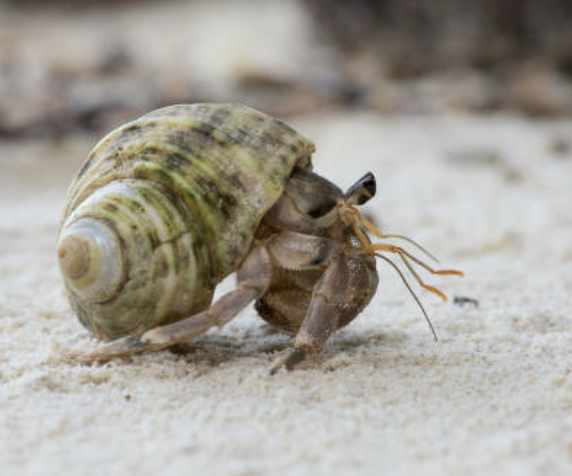
Hermit crabs are notable because their skeletons are as soft as the skin on one's finger. For protection they find a vacant shell and back into it, wrapping their abdomen and tail around the columella. To make this easier, they have lost the appendages on the right side of the abdomen. As they grow they need larger quarters and may sometimes be seen in the aquarium while trying on new shells for size. Terrestrial hermit crabs, kept as pets by many guests, have similar habits, but they cannot live in the water. Hermit crabs swallow mud and detritus, excreting what is not edible.
ROCK CRAB: Cancer irroratus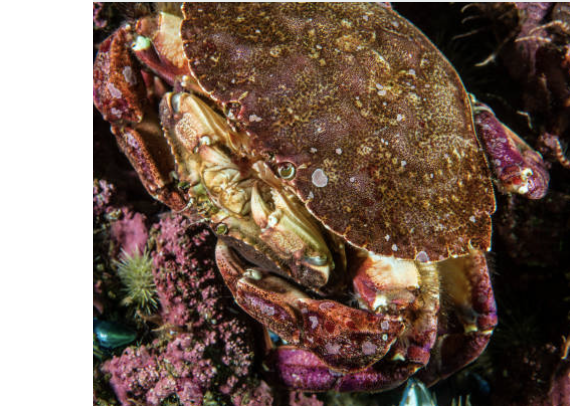

The rock crab has nine blunt marginal teeth on either side of its eyes on the front edge of its carapace (top of the exoskeleton). All five pairs of walking legs have sharp points so it can walk on algae covered rocks, but having no paddles, it cannot swim.
A pair of doors, the maxillipeds, are prominent on the anterior (front), ventral (underneath) side of the crab, where they protect the water intake siphons. This area also contains knife- or scissor-like mandibles that break up food. Rock crab claws are strong enough to crack mollusk shells. A favorite prey is young oysters with thin shells. Rock crabs are edible, and can be found on seafood menus in Northern New England.
GREEN CRAB: Carcinus maenas
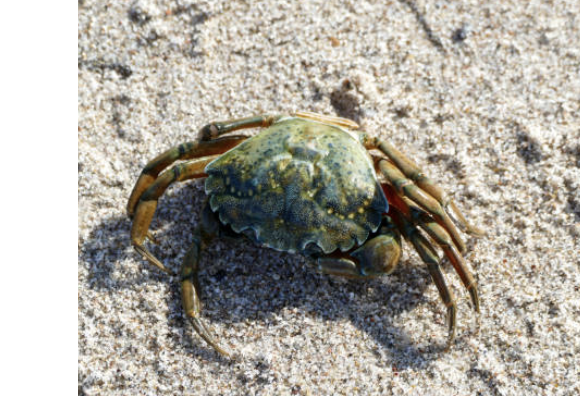
The green crab has a dull green dorsal top) surface decorated with white designs and spots. Adult females are red-orange underneath. Males and juveniles are yellowish. It has five marginal teeth on each side of its eyes along the front edge of its carapace, and three medial teeth between its eyes.
Although it does not have paddles, the slightly flattened surfaces on its last pair of legs allow it to swim, unlike the rock and spider crabs with which it shares the nearshore environment. The female's tail is broad with a point at the apex, and is often dark colored against the brighter ventral background. The broad tail truly looks like the Capitol Building, while the male's tail is more or less like the Washington Monument. The green crab can be pugnacious for its size and often remains slightly lifted on its feet with its claws spread, ready for action. This crab was not native to the United States: It was introduced to the East coast some years ago from the English Channel. It has now spread to the West Coast, where it is doing well.
Volunteer George Macintyre reports that while transferring a two inch female green crab to the touch tank, the crab suddenly molted. The carapace or back came off in one piece but the remainder of the shell fragmented, leaving a collection of pieces in his hand. About three hours later the crab had increased in size, by absorbing water, to three and a half inches wide. The exoskelton remained soft.
Another volunteer reported finding a female green crab with an egg mass tucked under her tail. The tan colored, slightly grainy, sponge-like material was about 1/4" thick, but the edges were smoothly even around the perimeter of the tail edge.
JONAH CRAB: Cancer borealis
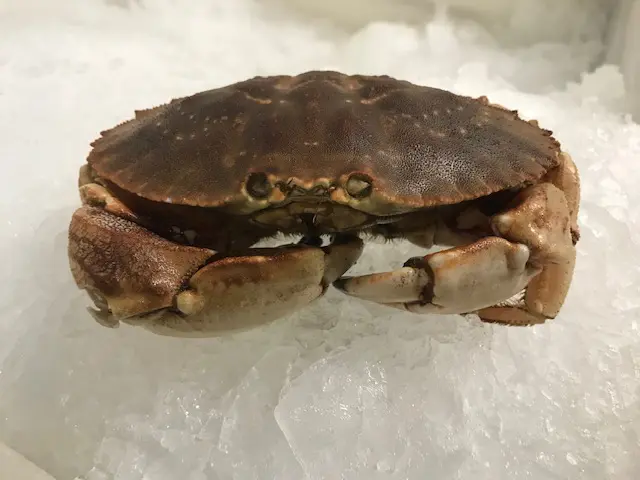
The jonah crab is not often available in the Touch Tank and can easily be misidentified as a rock crab which it resembles closely. It does, however, have a heavier body, shorter and thicker legs and noticeably thicker pincers.
LADY CRAB: Ovalipes ocellatus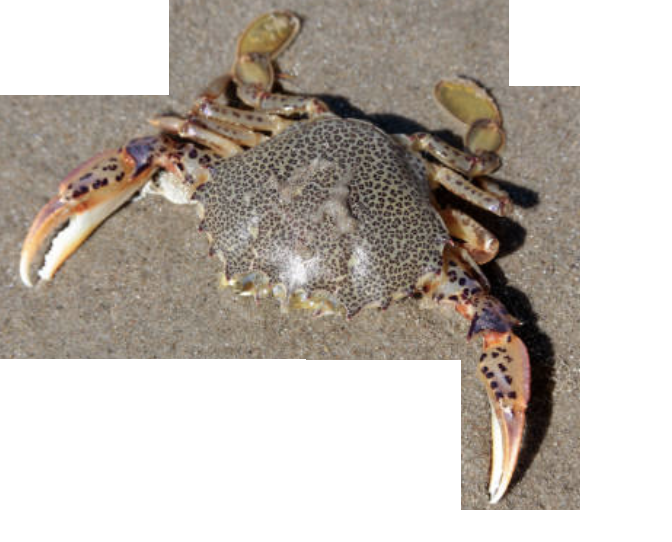
Another occasional animal in our touch tank is the lady crab, sometimes known as the calico crab, that lives in sandy areas where it can hide just below the surface. The lady crab is not happy in the rocks where it is more vulnerable. Its carapace is rounder than the rock crab and usually lighter in color. The tannish whitish back is covered with groups of purple spots. It has five marginal teeth on the front of the carapace on either side of the eyes. The last pair of legs has paddles, not points, making this crab a swimmer. The crab is active, and can deliver a sharp pinch. Like the rock and blue crabs, the lady crab is edible, but is too small to be of interest to the marketplace.
SPIDER CRAB: (Libinia emarginata ) and (Libinia dubia )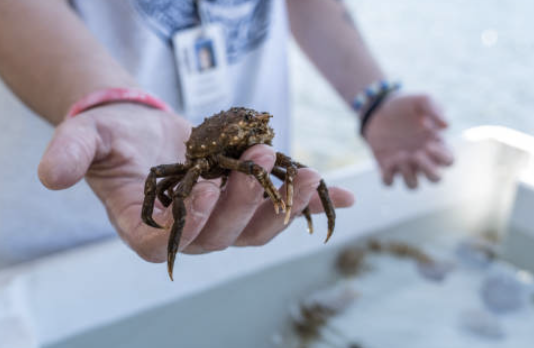
If there are six spines down the midline of the back it is L. dubia, and with nine spines it is L. emarginata. Dubia has a large beak. Both are called decorated crabs. Their bodies have chitinous hairs to help hold algae, anemones and bryozoans. Spider crabs cannot swim; all their walking legs end in sharp points to allow them to navigate slippery algae-covered rocks, and to hold on tightly when necessary. In both animals, the males have longer pincers or chelae. Female tails are circular, covering the entire space within the legs.
Spider crabs tend to wait for edibles to pass near rather than to go hunting as does the green crab. Large specimens may dine on a sea star's arm. The sea star can detach its arm when it is attacked, so the spider crab may not get the entire animal.
BLUE CRAB: Callinectes sapidus
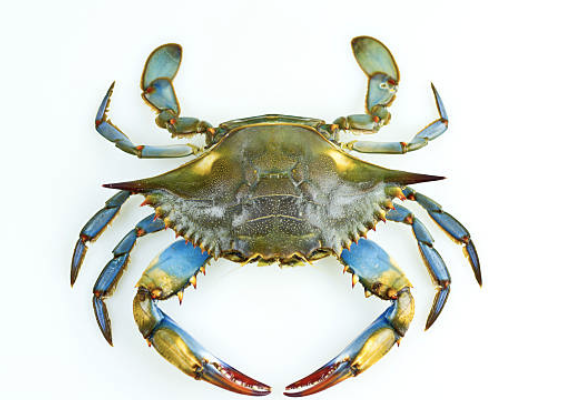
Blue crabs are native to the western Atlantic Ocean from Massachusetts down to Argentina, and around the entire coast of the Gulf of Mexico.
The blue crab's carapace can vary in color from bluish to olive green. It has nine marginal teeth on each side of its carapace. Claws are bright blue. They have three pairs of walking legs and one pair of swimming legs (paddles) in the rear. Males and females can be easily distinguished by their abdomens. Males have a long, tapered abdomen ("apron"), females broad and rounded. Females also have red tips on their claws.
Blue crabs feed on shellfish, small crustaceans and recently dead fish, as well as animal and plant detritus. Predators of blue crabs include, large fish, sea birds and sea turtles.
Due to their aggressive nature, we do not have our visitors touch the blue crabs. If we do have blue crabs in our touch tank, they will be displayed only in one of the non-touching side bays of the tank.
CHINESE MITTEN CRAB: Eriocher sinensis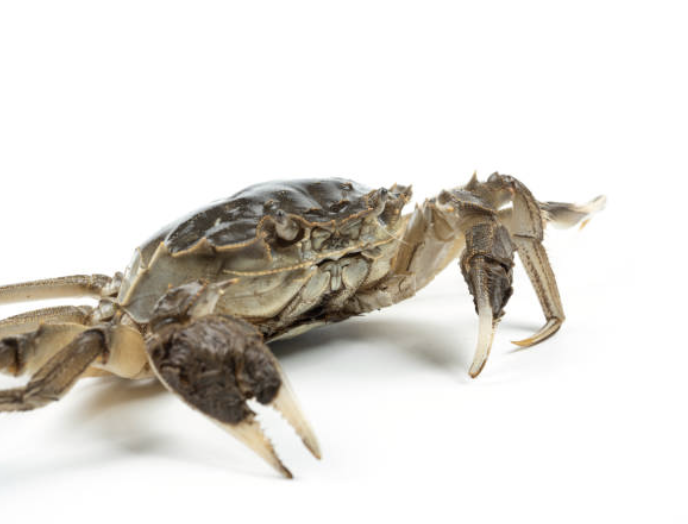
Invasive Species: Mitten Crabs are not native to Connecticut, but have recently been sighted here. Establishment of mitten crabs in Connecticut may have negative consequences for coastal and freshwater ecosystems.
Mitten crabs are brownish-orange to greenish-brown in color. They have hairy, white-tipped claws (look like mittens). Four spines along each side of the shell with a distinct notch between the eyes. Legs are twice as long as the width of the shell. Males have a V-shaped abdomen, females a U-shaped abdomen. Carapace can be up to 4 inches in width.
Mitten crabs are omnivorous, feeding on aquatic plants, algae, detritus, fish eggs and marine invertebrates.
Mitten crabs are not in our touch tank.
AMERICAN LOBSTER: Homarus americanus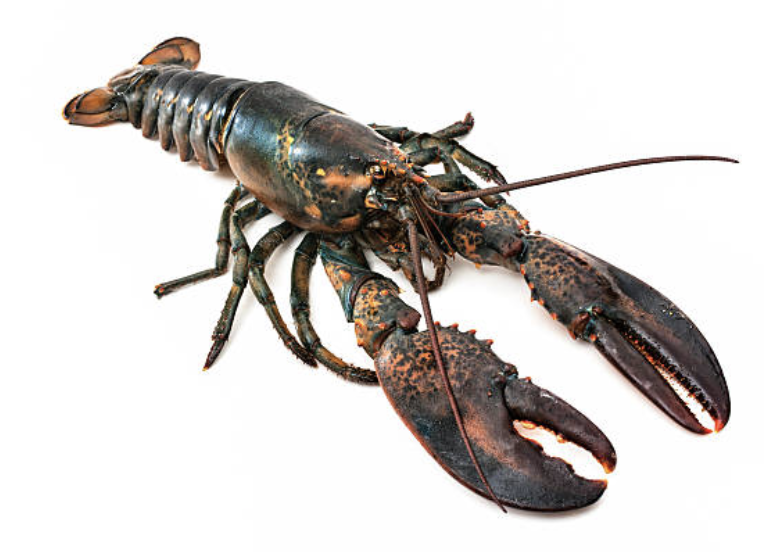
American lobsters are found on the Atlantic coast of North America, mainly from Labrador to New Jersey.
American lobsters are the heaviest extant crustacean in the world, weighing up to 44 pounds and reaching a body length of 25 inches. Average size of the American lobster is 9 inches and about 2 pounds.
While most American lobsters display a rusty brown coloration, many other color patterns have been observed, including green, blue, yellow, orange, spotted and some that are split evenly down the middle, with a different color on either side.
While we sometimes have lobsters in our touch tank, they will only be displayed in one of the non-touching side bays.